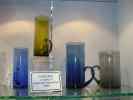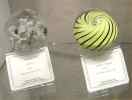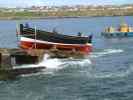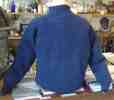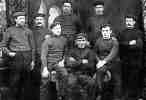|
|
|
|
Open Easter to
October
Guide Books in 10 languages - 50p
The
Wick Society
Caithness Glass Through The Years On Show At Wick Heritage Museum |
30 June 06
28 March 05
16 September 04 With detailed studies now completed, the Society recently agreed an action plan for conserving and developing the Wick Heritage Museum and its important collections. As a first step, selection of a suitable architect is under way. The architect will oversee the urgent repairs required to keep the existing premises in good condition, before attention turns to the construction of a museum and archive store on the adjacent property formerly known as Cowie�s Yard. The new, purpose-built store will include workshop and study areas and will be open to the public. This will relieve pressure on the current building and enable it to be refurbished over the long term. In parallel the Society plans to move ahead with the digitisation of the Johnston Collection of glass plate negatives, conserving the fragile negatives and enabling access to the digital images. Donald Sinclair, chairman of the Wick Society, is sure that the ambitious plans will encourage more people to become members of the Society. �This is an exciting time for us, but it will take a lot of hard work to achieve our aims. The Society�s Boat Committee has done very well in attracting new recruits to work on renovating the Isabella Fortuna and other projects. We now hope that we can welcome more new members to help with other aspects of the Society�s activities. The Museum and its collection are the heritage heart of Wick.� The Society has now begun to apply for the funding needed to carry out its plans. It is hoped that one of the first things to be achieved will be the creation of a project officer post to deal with the preparation and administration of the many funding applications that will be required. |
|
Wick Heritage Centre The Council is responsible for the outside of the buildings and the gardens, while the Society carries out all the interior work from wiring to the construction of the displays. All of the new building work on the extensions, and on the garden terraces, was carried out by the District Council, using Manpower Services Schemes, to Society designs. The co-operation between the District Council and the Society, who were often at loggerheads over redevelopment, is unique as both recognised in their different ways the need to preserve the town�s heritage and the Heritage Centre is the result of this co-operation. With a few exceptions, all the items are on loan by individuals or their families as the Society refuse to accept anything unless it is on loan and a receipt issued. The exceptions are where items of a strong local collection came up at auction and had to be bought. All the work in the Centre, from cataloguing to construction is carried out in the closed season, from October to May. As a general rule no more than 2 hours are spent per session with the members working on whatever their particular interest is. Regular work times are held on Monday and Wednesday nights and Tuesday, Thursday and Saturday mornings. The formal business of the Society, which has four office bearers, is conducted on the first Monday of every month. There is no elected committee as such and all members are eligible to attend and speak at each meeting. In summer, when the Heritage Centre is open, most of the general work ceases as members then help to guide visitors around, although at busy times this is not always possible. During this time the Society make one of the art galleries available free of charge for local creative talent to exhibit their creations. |
|
|
The Museum
The Centre is designed to gradually lead you through all aspects of life in the town. The contents run to many thousands of items in rooms and cases. Even more is held in storage and shown from time to time. A massive collection of photographs over half of which is derived from the Johnson collection. With 50,000 plus negatives from the collection catalogued their is a massive amount of information available. The pages on the web site can give you only glimpses of what is contained. The atmosphere of the various rooms and original buildings must be experienced. An original smoke room which still carries the smell of the time is like stepping back in time.. As with so much of this incredible museum the depth and range of items is staggering. Most of the items are on loan from local people and families. A number of paintings and works of art show local life in the gallery where you can also examine many of the pictures reproduced from the collections. Many of the photographs are available for sale in various sizes to help the funds of this voluntary organisation. From the smallest object like tools or whistles made from cabbage roots to major items like sea going boats - one of which the Isabella Fortuna now restored and sea worthy is housed in the old lifeboat shed. Several other boats and even the whole light from the top of a light house stretching through two floors completely taken
down and reassembled inside the museum - Do ask how they achieved that little feat? And on it goes to restoration work on Sinclair
and Girnigoe Castles and the
Whaligoe Steps. If you have never been inside what looks like a small museum on the outside you will be amazed by the time you are half way round. Do not think you will see it all in an hour. You could spend a week looking at the photographs alone. The complex actually extends though several buildings and stretches further back than the front of the building would suggest. Do not forget the harbour area brimming with much memorabelia. Equipment, diving suits. old signs. The machinery room with every kind of machine and engines from old fishing boats to masons tools and every conceivable tool from old craftsmen. Many pictures will appear here in the next couple of weeks. They will barely scratch the surface of the Wick Heritage Museum. You will step back into several times when you enter this gem in the north. Lighthouse The lighthouse is in three main parts. Beginning at the top you can see 16 triangular mirrors with 16 lenses and prisms in the shape of an umbrella and underneath 16 vertical lenses and prisms. One of these has been left out to give a good view of the lamp, which was made in France in 1848. This originally burnt oil but the Society has fitted electricity for ease of maintenance. As you know, the lighthouses flash every now and again so that seamen can tell which one they can see and this is done by making all the lenses and mirrors turn around the lamp which does not move. The lenses are turned by clockwork, which you can examine, downstairs, and the lenses magnify the lamp as they pass, which gives the appearance of a flash. If you stand away from the lamp as far as you can and look at it through one of the lenses you can see how powerful the lenses are. The mirrors are to reflect all the light, which is shining upwards, back into the main lenses so that no light is wasted. This lighthouse flashed every 20 seconds and came from Noss Head which is 3 miles north of Wick. You can see the mechanism downstairs. The lighthouse was dismantled and rebuilt by members of the Wick Society.
Photographs
Art Gallery
Reconstruction Kiln Clothing Barrel Making |
|




